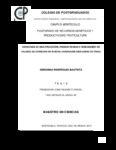Capacidad de multiplicación, productividad e indicadores de calidad de consumo de nuevas variedades mexicanas de fresa
Abstract
El presente trabajo tiene el objetivo de evaluar la capacidad de multiplicación, productividad e indicadores de calidad de consumo de las variedades mexicanas (CP-Jacona y CP-Zamorana) y extranjeras (Festival y Albion) de fresa. En comparación con las variedades mexicanas, ´Festival´ presentó mayor número de estolones, coronas y plantas hijas en el vivero de Zirahuén; sin embargo, el contenido de almidón fue mayor en las variedades mexicanas. En el vivero Tanaquillo, ´Festival´ y ´CP-Jacona´ presentaron mayor número de plantas hijas, aunque, el contenido de almidón fue mayor en ´Festival´ que en ´CP-Jacona´. En Zirahuén, la acumulación de almidón en plantas hijas fue mayor, en contraste, con el vivero Tanaquillo donde el número de plantas hijas fue mayor. En Zirahuén, ´CP-Jacona’ mostró baja capacidad de producción de estolones y plantas hijas pero éstas tuvieron el mayor contenido de almidón y el peso seco fue igual al de las variedades extranjeras y en el vivero Tanaquillo, las variedades mexicanas superaron a ´Albion´ en la producción de plantas hijas. Para la evaluación de la productividad, ´CP-Jacona´ presentó mayor producción en comparación con las demás variedades. De mayor a menor, el rendimiento acumulado se encontró ´CP-Jacona´ con 131.667, ´CP-Zamorana´ y ´Festival´ con 106.3444 y 107.245 t.ha-1, respectivamente, y Albion con 90.828 t.ha-1. No se encontraron frutos enfermos que afecte el ciclo de producción. Se encontró mayor porcentaje de mermas en peso en condiciones de temperatura ambiente hasta 34 %, en contraste, con frutos refrigerados donde se reportan pérdidas máximas de 20 %. El contenido de sólidos solubles y el porcentaje de acidez son mayores al inicio del ciclo producción y disminuye conforme avanza el la producción, por otro lado, el contenido de ácido ascórbico presenta valores máximos al inicio y final del ciclo de producción y el mínimo en el mes de febrero en ambas variedades. ´CP-Zamorana´ soporta una mayor carga de compresión, estadísticamente no existe diferencia entre la posición del fruto, sin embargo, la posición horizontal reporta valores mayores con respecto a la posición vertical, siendo este acomodo el ideal para transportar frutos de fresa. _______________ MULTIPLICATION CAPACITY, PRODUCTIVITY AND QUALITY INDICATORS OF CONSUMPTION OF NEW MEXICAN STRAWBERRY VARIETIES. ABSTRACT: This work has the aim of assessing the performance of multiplication, productivity and quality indicators of consumption of Mexican varieties (CP-Jacona and CP-Zamorana) and United States (Festival and Albion) of strawberry. In comparison with Mexican varieties, ‘Festival’ produced more runners, crowns and daughter plants in the nursery of Zirahuén, but starch content was higher in the Mexican varieties. In Tanaquillo nursery ‘Festival’ and ‘CP-Jacona’ had the highest number of daughter plants; however, the starch accumulation in daughter plants was higher in ‘Festival’ than in ‘CP-Jacona’. In Zirahuén, the root starch content of daughter plants was higher than in the Tanaquillo nursery, but the number of daughter plant produced was notably higher at Tanaquillo’s nursery. At Zirahuén, ‘CP-Jacona’ had a low capacity of runners and daughter plants production but these plants showed the highest root starch content, but the dry weight of daughter plants was similar to foreign varieties. At tanaquillo, Mexican varieties were better than ‘Albion’ in production of daughter plants. For the evaluation of productivity, "CP-Jacona 'showed higher production compared to other varieties. From highest to lowest cumulative yield was found 'CP-Jacona' to 131,667, 'CP-Zamorana' and 'Festival' with 106.3444 and 107,245 t.ha-1, respectively, and Albion with 90,828 t.ha-1. Diseased fruits weren´t found to affect the production cycle. The highest percentage of weight reductions in ambient temperature up to 34%, compared with chilled fruit which reported losses of 20% maximum. The content of soluble solids and acidity percentage is greater at the beginning of production cycle and decreases as the production progresses, on the other land, the ascorbic acid content has maximum values at the beginning and end of production cycle and the minimum in the February in both varieties. 'CP-Zamorana' supports a greater compressive load; statistically no difference between the positions of the fruit, however, reported higher values horizontal position with respect to the vertical position and this arrangement ideal for transporting fruits of strawberry.
Collections
- Tesis MC, MT, MP y DC [138]

